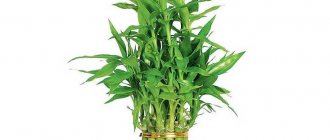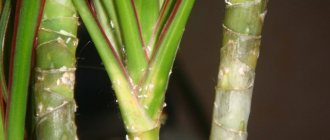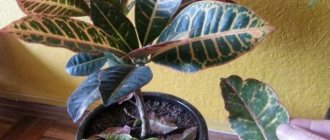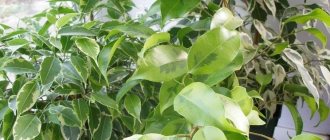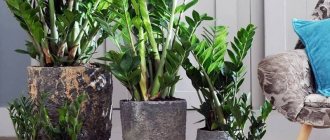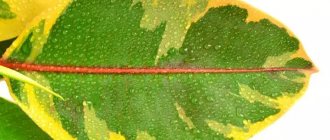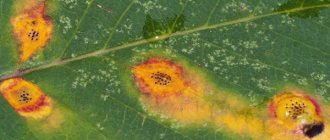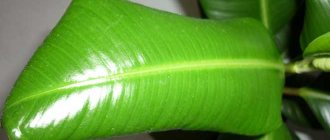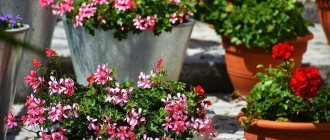Among lovers of indoor flowers, dracaena (from the Latin Dracaena), which is also called the false palm, is very popular. About 150 species of this plant are known in nature. It not only pleases the eye at home or in the office, but also enriches the air with oxygen. Proper care and timely recognition of diseases guarantee a long life for the flower. Yellowing and falling leaves is a serious signal to think about finding the cause that caused such symptoms. Below we explain why dracaena leaves fall off and what to do to save the flower.
Temperature and humidity
Dracaena feels comfortable at a temperature of 18-28 degrees.
A drop below 15 degrees is already critical for it. The leaves may look drooping if you freeze the flower. First aid is a warm shower. During a particularly hot period, you can place the flowerpot on a tray of water so that the bottom of the flowerpot does not come into contact with the surface of the water. As water evaporates, it humidifies the air.
Avoid direct sunlight, but do not hide in the shade when the sun is low on the horizon. The light should be evenly diffused. In winter, additional artificial lighting is needed.
As you can see, creating conditions for the growth of dracaena is not so difficult. An evergreen palm tree up to 35 years old is considered young and blooms from 1 to 7 times a year. Let your tree of happiness please the eye for many years.
Why did the dracaena drop its leaves?
- My dracaena dropped its leaves as soon as I took it out to the balcony after the winter, no matter what I did, but the leaves did not rise, but they returned it back to the room in 3 days, the beauty rose and is now standing, all the leaves have blossomed.
- Although dracaena is an unpretentious indoor plant, in order for it to be beautiful and lush (the leaves look up), you need to properly care for it. The first signs that the dracaena does not have enough care are drooping leaves, the leaves turn yellow and fall off too often.
Dracaena does not like to be watered too often. The earthen ball should dry out before the next watering. Young plants need to be replanted every year and at the same time increase the size of the pot by 1-2 fingers so that the roots are not crowded.
Perhaps the cause of drooping leaves is a lack of nutrients. You need to feed the plant at least once a month (or once every 2 weeks). I use liquid vermicompost for feeding.
Dracaena also loves the presence of oxygen at the roots. Therefore, it is necessary to periodically loosen the soil on the surface.
In the summer, spraying has a beneficial effect, but only this should be done in the evening, when the sun is not so strong (if you have a plant on the balcony).
- Dracaena does not like dry air. This time. It needs to be sprayed. In addition, if it’s hot in your winter, then in your apartment the dracaena will always have such drooping leaves. They will turn yellow over time. It was 24 degrees for me and the dracaena was very bad.
- Perhaps she is standing on your sunny side and it may be hot for her. Put it in the shade or just open a window so that the plant doesn’t feel so hot. And in summer you need to water the flowers twice a week than in winter.
- Dracaena rarely drops its leaves. If this happens, it means they didn’t take good care of the plant, or they weren’t at home for a long time.
It should be taken into account that dracaena is very sensitive to drafts. If you put it in a draft, then not only the leaves will fall.
Also, you should not place the flower in bright direct sunlight.
There is no need to overwater the plant.
Moderate watering will save the dracaena from root rot.
The plant needs to be sprayed more often. Dracaena loves this, and the leaves will stand up like the ears of a hare in the cold.
The soil into which dracaena is transplanted or planted should not be heavy. It should be well filled with oxygen. It is possible, and indeed necessary, to make drainage for 1/3 of the planting area.
The soil needs to be loosened more often.
Dracaena will live longer.
- My dracaena dropped its leaves after we started opening the windows for ventilation in the summer. I fertilized it and reduced the number of leaves, rejuvenating it, but to no avail. I removed it from the window into the room and within a day the plant came to life, all the leaves rose. Most likely she dropped her leaves due to a draft and dry air.
- Our dracaena dropped its leaves after moving. The move was in winter and the plant simply froze, the leaves seemed to have withered. It was never possible to revive her completely, but she still mostly recovered over time. This could also be caused by a draft or too sunny place.
Diagnosis of the problem
The plant gives the grower unambiguous signals. Deterioration in its appearance is a clear sign of health problems
It is important to interpret these signs correctly and know what to do in each specific case.
Table: symptoms and possible causes
| External manifestations | Possible reasons | |
| Errors in care | Disease | Pest |
| Yellowing and withering leaves. | Their lifespan is about two years. Otherwise - excessive watering | |
| Fading, shrinking leaves, deformed, thinning trunks. | Lack of light. | |
| Falling green leaves. | Unsuitable room temperature (both high and too low), constant cold drafts. | |
| Drying, curling and falling leaves. | Too little watering. | |
| Dry brown leaf tips. | Low indoor humidity. | |
| Dry tips and small areas of dead tissue on the leaves. | Excess fluoride in the soil - using unsuitable fertilizers or watering with hard, unsettled water. | |
| Leaves losing color and yellowish or almost discolored spots on them. | Burn from prolonged exposure to direct sunlight. It is almost inevitable if the plant has been sprayed before. Water drops focus rays just as well as lenses. | |
| Yellowish-white spots on the leaves, dry edges. | Low room temperature or sudden changes. | |
| A discolored “watery” border along the edge of the leaf. | Excess fertilizer in the soil (too frequent fertilizing). | |
| Reddening leaves. | Unsuitable, too heavy soil with a predominance of peat. | |
| Small white crystals on the underside of the leaf. | A natural phenomenon provoked by a single heavy watering combined with high humidity. | |
| Slow growth or its complete absence. | Unsuitable soil, lack of fertilizing for a long time, or too tight a pot. | |
| A coating similar to flour on the leaves. | ||
| Brownish trunk, soft to the touch. | ||
| Brownish spots, gradually becoming covered with gray “lint”. | ||
| Dark “watery” spots, softening tissue. | ||
| Yellowing leaves covered with dark brown spots. | ||
| Reddish-yellow, gradually turning brown spots on the leaves. | ||
| Brown spots on leaves with a bright green border. | ||
| Small beige spots with a white dot in the center. | ||
| Elongated beige spots with a pale red border. | ||
| Vague brown spots with a yellow-green border. | ||
| Dark “watery” tips of leaves, “ulcers” on the trunk. | ||
| Brownish spots and stripes cast in bronze. | ||
| Yellow spots on the leaves, petioles entwined with cobwebs. | ||
| Silvery “scratches” and small black dots on the leaves. | ||
| Brown “plaques” on the leaves, reddish-yellow tissue around them. | ||
| Small lumps of whitish substance in the axils of leaves and in the soil. | ||
| Many small yellow-green or black-brown insects on the underside of the leaves and sticky drops on them. |
What errors in care lead to: examples in the photo
Dracaena, whose leaf tips dry out, suffers from too low air humidity or sunburn. Dracaena can shed its leaves for several reasons, including natural ones. This is what dracaena most often looks like before shedding its leaves. Dracaena can very easily get burned if it is sprayed leave the plant in direct sunlight. Browning, drying leaves of dracaena mean long-term neglect of the plant's need for moisture. Yellowing of leaves of dracaena reacts to overwatering
Why do dracaena leaves droop: what could be the reasons?
First of all, you need to know that regular yellowing and falling of the lowest leaves is a natural process that accompanies the growth of a tree. On average, the maximum age of each leaf is 2 years, after which it dies and young leaves grow to replace it.
Healthy crown of Derema dracaena
If wilting exceeds the natural norm, covers the entire crown or more than half, this is a clear sign of a violation of agricultural practices, disease or damage to the tree by some pests.
For your information! Normally, the leaves are directed upward and form an acute angle with the crown and trunk.
If the dracaena has dropped its leaves, it is necessary to find out what caused it.
Diseases
Improper care becomes the source of various diseases. A weakened plant's immunity decreases and it becomes defenseless against fungal, bacterial and viral infections. Among the most likely:
- Alternaria blight. Light brown spots with a whitish core appear on the trunk and leaves, gradually becoming gray-black. Treatment with topaz helps against the disease;
- brown spot (phyllosticosis). Irregularly shaped beige-brown spots appear with a lemon-green border along the edge with small black grains gradually appearing. Most often, the disease affects mature palm trees. For prevention and treatment, every month you need to spray with a solution of foundationazole;
Alternaria blight on dracaena leaves
- bacteriosis This is when the leaves turn brown at the tips, small small sores appear on the trunk, and the crown quickly begins to turn yellow. A yellow oily stripe is visible between healthy and diseased leaf tissue. There is no treatment, since the disease develops for a long time on a weakened plant whose roots are damaged due to long-term waterlogging and too hot air temperatures. You can try to root the cut shoot if there are no signs of disease on its leaves yet, and there is no characteristic brown ring on the cut wood, indicating bacteriosis;
- root rot. The roots and the beginning of the trunk turn brown, the soil in the pot becomes covered with fluffy whitish mold, the dracaena begins to drop its leaves, and a characteristic putrid odor appears. To get rid of the disease, complete replacement of the soil, sterilization of the pot, cutting out all diseased tissues while capturing healthy ones, and subsequent watering for 3-4 months with a weak solution of Previcur or Baikal-M will help.
Healthy cuts of dracaena wood without signs of bacteriosis
Pests
Dracaena is not spared the pests that are common to most indoor plants. If this causes the dracaena to hang its leaves, there are a lot of options for what to do. The most common parasites:
- scale insect Characteristic small (1-3 mm in diameter) rounded brown plaques appear on all parts of the plant. The pest hides in them. Green tissues around them become yellow-red. The most effective control measure is double treatment with aktar with an interval of 5-7 days;
- spider mite It is difficult to see, but its appearance is signaled by tiny cobwebs on all parts of the plant. Only treatments with acaricides help against ticks, among which sunmite and agrovertin have proven themselves well;
- thrips. Their appearance is signaled by discoloration of the leaves; numerous tiny black dots and beige-gray scratches are visible on the underside. Treatment with Fitoverm or Actellik three times with an interval of 5-7 days is required;
- mealybug. It can be seen in the axils of the leaves. Accumulations of the pest resemble a coating of dirty cotton wool. They are treated against scale insects three times with an interval of 5-7 days with Mospilan or Iskra-Bio solutions;
- aphids are visible to the naked eye. Small insects are green or brown. They leave behind a sticky coating on the leaves. The plant must be washed under a warm shower and then treated every 5 days with Admiral or Biotlin solutions until the aphids completely disappear.
Soil moisture
A healthy dracaena is a very moisture-loving plant, actively absorbing moisture from the soil with its roots. However, you cannot keep the substrate wet all the time. Between waterings, the soil should dry out to a depth of 3-4 cm. With a stick, which should be in the pot at all times, it is necessary to regularly check the degree of drying of the substrate. Typically, an adult plant requires watering every 2-3 days in summer, and 2-3 times less often in winter, depending on the temperature and age of the palm tree.
A typical view of dracaena leaves, whose roots systematically dry out
Broad-leaved species are more demanding when it comes to watering, since they have a larger area for moisture evaporation. In hot summers they can be watered every day. Narrow-leaved species are easy to water because they consume water more slowly. Drying of the roots is signaled by drooping leaves, which can be raised by spraying and regular watering.
Important! The next day after watering, be sure to loosen the soil in the pot.
Air temperature
In summer and spring, the optimal air temperature for most types of dracaenas should be between 20 °C and 25 °C. Hotter air will not lead to death, but will make maintenance more difficult and may cause the crown to lose its attractive appearance. When asked why dracaena dropped its leaves in summer, the most common answer is overheating and drying out the air.
In winter, a slight decrease in air temperature to 17-19 °C is recommended. It cannot be lowered below 15 °C. However, species such as Hooker's, fragrant and Dragon's dracaenas can survive short-term cold snaps of up to 10 °C without damage.
Note! Sudden temperature changes and cold drafts are very harmful. If the plant begins to drop leaves, this may indicate hypothermia.
Root rotting
The first reason for damage to the root system of dracaena by all kinds of fungi and rot is waterlogging of the soil. In this case, no matter what time of year it is, you need to do the following. The plant must be removed from the pot, shake off all the soil and planted in new sterile soil. The pot must be disinfected with alcohol or a bactericidal solution.
If you replant on time, there is a high probability of saving the palm tree. If there are wet, unpleasant-smelling, brown-black areas on the roots, then they are cut out completely to healthy tissue. It is recommended to soak it before planting in a new substrate for several hours in a solution of potassium permanganate or phytosporin. There is no need to water the plant for 2-3 days. You can only carefully spray the leaves with a fine spray bottle 2 times a day. Watering is resumed carefully, adding bactericidal additives, for example, phytosporin, to the water.
Important! With such a transplant, you should absolutely not increase the volume of the pot, and if most of the diseased roots are removed, then the capacity is reduced.
Causes of diseases
Ficus is a house plant that enjoys well-deserved fame among floriculture lovers. The flower is cute and unpretentious, with large and beautiful leaves. The tree is considered a long-livers, it lives up to 12-15 years.
Sometimes ficus trees can develop various kinds of diseases. They usually occur due to improper or negligent care. Pests emerge from contaminated soil, quickly attacking the roots and destroying the plant. Or the flower may freeze and die from fungi and other related infections.
Maintenance is generally simple and the requirements for gardeners are the usual - water regularly (without overwatering and not too often), do not expose to severe overheating and avoid direct sunlight. It is advisable to maintain the air temperature in the room at a standard temperature for our climate, without sudden changes; extreme temperatures should be avoided.
Ficus is never placed near a heating radiator. If heating devices are located nearby, then a moistened cloth is placed on them and on the windowsill for protection, and the surface of the flower is often sprayed with small drops. If the humidity, on the contrary, is high, then it is advisable to wait until the soil dries 2-3 cm, and then continue watering.
A number of species shed leaves in autumn and winter, but this is a gradual and painless process for the plant. If the leaves fall off too quickly, then the ficus does not have enough water or there is not enough soil in the pot, or it needs to be transplanted into soil more saturated with nutrients. The green tree does not like open ground and often change its location in the house.
If the grower takes diligent care of the plant, then the risk of disease is minimized. However, sometimes cuttings and young stems may have hidden diseases that are not noticeable at first glance. Infections and parasites (for example, nematodes) are introduced from the soil. Ficus often dies from them.
It is recommended to fertilize ficus in the warm season - once every two weeks. With the onset of autumn, they feed less often; in winter there is no need to touch the flower. Nourish the soil according to the instructions on the package so as not to overfeed. The leaves also react to excess feeding - dots and specks appear on them.
If rot appears at the base of the root, the leaves wither and curl, the culprit is most likely constant flooding. If the ficus stops growing, the soil is depleted and mineral resources are running out.
Flower shops sell soil that contains the minerals and vitamins that ficus needs for growth.
Diseases
A yellowish tint on dracaena foliage most often occurs due to a plant disease. It is very difficult to tolerate sudden changes in temperature. If you move a flower from the street to a very hot room, the edges of its leaves will begin to crack.
Why do dracaena leaves fall off - reasons
The plant also begins to hurt if it has been in the sun for a long time. Direct rays cause burns. But the lack of light is also detrimental to tropical culture. This causes the foliage to fade and become faintly colored.
Dracaenas are often susceptible to infectious diseases. In this case, the following symptoms will additionally appear:
- slowdown in plant growth;
- yellowing of leaves and then their falling off.
Infectious diseases are transmitted from other plants or introduced into the soil by tools during loosening. If the onset of symptoms is ignored, the flower may die.
The appearance of dark brown spots on the tips of the leaves indicates the development of a bacterial infection. The stem may turn black at the base, then begin to rot in the area of the petioles. An unpleasant odor appears. If the infection is mild, it is possible to remove the diseased foliage and then spray with a growth stimulant. These measures will reduce the development of point disease.
Important! If the bacterial infection gets worse, it will be impossible to save the flower. Plant owners may experience fungal infection
Symptoms will include yellowing of the leaves, small brown spots with a red edge, and fungal spores will be visible on top of the spots.
Plant owners may encounter fungal infections. Symptoms will include yellowing of the leaves, small brown spots with a red edge, and fungal spores will be visible on top of the spots.
If the dracaena is affected by a fungus, it is necessary to remove the diseased leaves and stop spraying the plant. Then treatment should be carried out with a series of biological products.
Another infectious pathology to which a tropical plant is susceptible is Fusarium spot. When a flower is infected with it, the leaves rot, and watery spots with a yellow edging appear on the plates.
The plant will begin to dry out and shed its leaves if mold appears in the soil. Many indoor flowers are susceptible to this phenomenon. Most often the problem occurs due to improper care. Poor soil quality, insufficient lighting, high humidity levels - all this leads to the formation of mold. You can save dracaena only if you transplant it into new soil with drainage
It is important that the soil is loose
Infectious diseases of dracaena are manifested by yellowness on the leaves and the appearance of brown spots
Air temperature
The reason why Decembrist's leaves turn red and wither may be hypothermia of the flower. For the Decembrist, a temperature of +14 degrees is considered critical. With it, necrotic processes begin in plant tissues. With a further decrease, the plant begins to fade sharply. Initially, the upper leaves lose turgor, and then the rest.
The flower can only be saved by raising the temperature to +18 degrees or more with moderate watering.
Only by knowing the main reason why Decembrist leaves turn red and wither, and what to do in this situation, can the plant be restored, otherwise it will die.
Increased air temperature can also provoke a problem with the leaves of the Decembrist. With insufficient watering, the plates intensively evaporate moisture, and have no way to replenish it. Therefore, it is recommended to water the plant regularly during hot periods, preventing the earthen clod from drying out. You should also additionally spray the above-ground part in the morning so that the flower has time to absorb moisture before the evening.
In winter, the flower should not be placed close to the heating system. To prevent the flow of hot air from the battery to the pot, it is recommended to lay a sheet of polystyrene foam, the width of which will be slightly larger than the window sill.
Important! In summer, the plant should be shaded from direct sunlight, and the pot should not be overheated
Soil moisture
The main reasons why begonia leaves dry out
Despite its love of moisture, dracaena should not be constantly moistened. After each watering, you need to wait until the soil dries to a depth of 3-4 cm.
For reference! The degree of drying of the soil is checked with a stick - it is stuck into the ground 4-5 cm, taken out, then look at the condition of the soil at the tip.
An adult specimen is watered every 2-3 days in the summer. In winter, the frequency of watering is reduced by 2-3 times, depending on the age of the flower and air temperature.
Broad-leaved representatives of dracaena have high demands on moisture. In summer they are watered daily. Narrow-leaved specimens consume much less water. They can be easily filled. Drooping leaves are the first sign of dry roots. Regular spraying and watering will correct the situation.
Important! We must not forget about loosening the soil in the pot after each watering.
What to do with a broken dracaena palm
Dracaena is a rather massive plant, so the above-ground part can simply outweigh the pot. Also, often the “fractures” she received are the result of the vigorous activity of children and pets. In this case, do not be upset. If done correctly, instead of one plant you will get two.
A broken dracaena is not a reason to cause a tragedy
The easiest way is when the barrel is broken, but not broken completely. “Splints” are placed on it, as if on an arm or leg, and the skin is fixed so that it covers the “wound” as much as possible. You can wrap the top with strips of sphagnum moss or coconut fiber.
Don't forget to "seal" the cut you make.
Otherwise, the remaining part of the plant in the pot:
- Saw off the trunk evenly just below the damage site. It is advisable to do this along the “scars” left by fallen leaves.
- Disinfect the cut with a bright pink solution of potassium permanganate or 1% Bordeaux mixture.
- Fill with liquid wax, paraffin, cover with garden varnish. If you don't have anything on hand, apply 2-3 coats of oil paint.
- Place the plant in partial shade. Water moderately. When growth buds form, return to normal care.
The side buds on the dracaena “wake up” for quite a long time, be patient
Broken top:
- Cut at an angle of approximately 45º. Try to do this as smoothly as possible, without fraying or nicks. Let dry for 2-3 hours.
- Remove offending leaves. Place in a container with the biostimulant prepared according to the instructions. You can use succinic acid and activated carbon (one tablet for every 200 ml). An alternative is rooting in damp perlite, vermiculite, or sand. The cut will need to be sprinkled with any powdered root formation stimulator.
- Change the water every 3-4 days, moisten the substrate regularly. Provide bottom heating, at least 12 hours of daylight and a temperature of approximately 25ºC.
- Be patient. The rooting process can take 3–4 months or even six months. When the first new leaf appears, replant the plant in soil suitable for adult dracaenas.
Most often, the broken top of dracaena is rooted in water
Video: rooting dracaena cuttings
Dracaena, like any indoor plant, is not immune to attacks from diseases and pests. However, it is quite resistant to them, and a tree that is properly cared for rarely suffers. However, individual errors in care, pathogenic fungi and bacteria can cause a deterioration in the appearance of dracaena. If nothing is done, the plant may even die
Therefore, it is important to be able to recognize what causes certain symptoms and know what to do to cope with the problem.
Dracaena is considered a very unpretentious indoor plant. She doesn't need special care. But in order for the flower to please the eye with its splendor and beauty for as long as possible, react in time to any changes in its appearance. What do the drooping leaves of the dracaena say?
Let's look at why this problem occurs and what needs to be done to solve it.
There may be several reasons:
- improper watering;
- unsuitable flowerpot;
- nutritional deficiencies;
- lack of moisture;
- drafts and disturbed temperature conditions;
- the plant was frozen.
Root rotting
The roots of the plant may rot due to waterlogged soil. This is another reason why dracaena leaves droop. In such a situation, the bush is transplanted into a new pot, previously disinfected with alcohol. It is important to make the transplant on time.
Transplanting dracaena into a new pot
You can save the flower by following these steps:
- Carefully remove the bush from the container and wash off any remaining soil from the roots.
- Trim off parts of the root damaged by rot with sharp pruning shears. At the same time, capture 3-5 cm of healthy tissue.
- Place the roots in a pink solution of potassium permanganate or Bordeaux mixture.
- Sprinkle the cut areas with wood ash or colloidal sulfur.
- Transplant the bush into a sterilized container with new soil.
Important! The culture is also watered with a five percent solution of Previkur or Apirin-B for 3-4 months.
The leaves are falling
Why does croton shed its leaves? What to do?
If the trunk of the codiaum is exposed at the bottom, this is a completely natural process of the death of old leaves.
Why do croton leaves fall off in the fall? This is quite normal, a pattern, in the same way at this time of year the leaves of birch trees or, for example, maples fall.
Why do croton leaves fall off? What to do? But if the top leaves also begin to fall off, the reason for this is most likely either a sharp change in the temperature regime, or too low a temperature, under which the codiaum remains for a long time.
First of all, to eliminate such a phenomenon as leaf falling, you need to take care of the conditions under which the croton is kept. It is also a good idea to use fertilizing to restore the health of the plant.
When croton sheds its leaves, the reason may be stagnation of moisture, as a result of which the root system rots. If you find that this is the reason, cut off the apical cutting and try to root it in order to re-grow the flower if the existing one dies. That's why the leaves of the croton began to fall.
Care
Dracaena is an unpretentious plant, so caring for it is simple and not burdensome. This is a light-loving plant, so it is preferable to place it on southern windows. However, during the height of summer, your pet needs to be shaded.
They need to be watered frequently, but moderately. In the summer - every other day, and do not forget to take a warm shower every week. To do this, you need water at room temperature.
When the room temperature drops to 14-16 degrees, reduce watering and the plant falls asleep. For irrigation you need to use filtered or boiled water. And you also need to remember the main rule: waterlogging is always more harmful than drying out. This rule is also relevant for dracaena, although it is moisture-loving.
If there is a lack of nutrients, even green leaves may fall off. You need to feed it with special fertilizers. Use them according to the detailed instructions on the packaging.
Why do dracaena leaves turn yellow and fall off?
So why do dracaena leaves turn yellow?
Failure to comply with temperature and humidity standards
Dracaena loves spraying, this helps increase air humidity and protect the plant from drying out the tips of the foliage. This problem occurs especially often in autumn and winter, when the heating is turned on and the air in the apartments becomes quite dry. To solve this problem, you should use a humidifier or spray the dracaena with a spray bottle.
Dracaena has several varieties that are popular, most of them do not tolerate direct sunlight, they can burn the greens. The first sign of too much sun will be the foliage fading and becoming faded and dull. Most often this problem occurs in the summer; it is enough to move the plant into the shade or remove it from direct sunlight.
Important! Dracaena does not tolerate drafts at all; this fact should be taken into account when choosing its place of residence. If the plant decides to drop its leaves, then it means it is beginning to die, urgent measures should be taken
The optimal growing temperature for this palm tree is from 180°C to 250°C. When the air temperature drops below 16 degrees, the plant may become ill, its condition will worsen, as will its appearance, the foliage may droop. Cold drafts are especially dangerous in winter.
Insufficient plant nutrition
If the dracaena does not have enough nutrients, even green leaves may fall off. For feeding, special fertilizers for palm trees are used. You should carefully read the instructions for use that come with the product.
Spots on dragon tree leaves
The soil must be nutritious and have good water and air permeability. Oversaturation of the soil with fluoride will cause the ends of the dracaena leaves to turn yellow. Then the treatment can be long-term.
Other Possible Problems
There are other reasons why leaves begin to wither and die:
- trunk damage;
- slow growth;
- redness of leaf blades;
- sunburn.
If the trunk is broken, then the broken area needs to be trimmed with pointed pruning shears. Afterwards the cut is sealed with wax. This will prevent it from drying out. A flower that grows slowly is transplanted into fertile soil and fertilized. The same is done in the case of reddening of the foliage. The bush on the windowsill is sprayed in the evenings, when the sun sets, so that the leaves do not turn yellow.
Now the florist knows why the dracaena leaves droop and what to do in such a situation. The rules described above will help to revive the flower and it will again delight its owners.
Fungal and bacterial diseases
Improper care, which leads to a weakening of the defenses, is the most common cause of damage to dracaena by fungal and bacterial diseases.
Alternaria or concentric spot
Signs of Alternaria blight are dry, round spots on the leaves and other parts of the plant. Their shade is most often light brown, and in the center you can see a white dot and concentric circles. Upon closer examination of the foci of the disease, dark or light inclusions of fungal spores are visible, which, as Alternaria spreads, provoke blackening of dry spots.
Treatment of Alternaria involves the use of fungicides. Not only “Fundazol” is suitable (dosage – 10 g per 0.5 liter of water), but also “Topaz”, “Oxychom”. You need to spray the bush at least 3 times, observing a 10-day interval.
Phyllosticosis or brown spot
To treat dracaena, three treatments with any available fungicide are used with an interval of 10 days. It is recommended to alternate medications to prevent the fungus from becoming accustomed to them.
Heterosporosis
The disease affects both sides of the leaf blade, in the initial stages causing the appearance of oblong yellowish spots. As heterosporosis spreads, the spots darken and acquire a brown tint, and a dark red border becomes pronounced. At an advanced stage of the disease, there is an increase in foci and the appearance of fungal spores.
The danger of heterosporosis is its rapid spread and damage to the entire plant, which dies if left untreated. The apical shoot is the first to suffer, and then the remaining parts of the dracaena, which turn yellow and dry out. At risk are specimens that grow in rooms with dry air and insufficient moisture.
Effective means of combating heterospora are fungicides “Topaz”, “Strobi”, “Maxim”, “Skor”, “Quadris”, “Falcon”. You can also treat the bush with a solution of Bordeaux mixture according to the instructions. It is advisable to carry out 3-4 sprayings to completely destroy the fungus.
Bacteriosis
Bacteriosis is a dangerous bacterial disease that cannot be treated. Most often, it affects dracaenas planted in a substrate with a high alkali content, as well as specimens suffering from a lack of fresh air and poor ventilation in the room, heat, soil depletion, constant dampness and systematic waterlogging of the soil. As a result, the bushes' immunity weakens and they become more susceptible to bacterial attacks.
Bacteriosis can be recognized by several signs:
- Wateriness at the tips of leaf blades and their darkening;
- Rotting lesions on leaves that feel damp when touched. After the stains dry, a characteristic film remains;
- Small round ulcers that form not only on the leaf mass, but also on the stem;
- The appearance of characteristic yellow stripes that separate the diseased and healthy parts of the leaf blade.
It is noteworthy that bacteriosis of dracaena can spread to neighboring plants, especially those that are in close contact. The risk of infection increases significantly in the case of spraying, when water gets on parts of the diseased and healthy flowers.
If dracaena gets sick with bacteriosis, throw it away without regret. Any delay risks infecting the entire collection, which will soon die. Be sure to disinfect the pot with boiling water or a solution of potassium permanganate before planting another indoor flower in it.
Pests
Due to harmful insects, dracaena can become sick and lose its leaves. Parasites must be eliminated immediately after detection. The most common pests are scale insects, spider mites, aphids, and mealybugs.
Shchitovka
Why do dracaena leaves turn yellow and fall off?
The presence of the pest is indicated by rounded brown plaques 1-3 mm in diameter, covering all parts of the plant. The pest uses them as cover.
The leaves will turn yellow-red and begin to droop, dry out and die. The insect itself can be removed manually with a sponge soaked in soapy water.
Attention! The most effective method of control is to treat with Aktara 2 times at intervals of a week.
Spider mite
This small insect, 0.5 mm in size, is yellow-green in color. It is very difficult to see. The mite settles on the inside of the leaf, where white spots will appear over time.
The damaged areas will be covered with formations resembling a web. Leaves may turn yellow and darken.
Treatment of dracaena consists of treatment with a soap solution heated to +50 ° C and spraying with Actellik or Fitoverm. Spraying is carried out only after the bush has dried.
Aphid
Small pests severely damage the upper parts of the shoots and the lower parts of the plates, sucking the cell sap from them. Infected leaves lose color, turn yellow and fall off. Timely treatment will help prevent the death of the plant.
Insecticides are used to control these pests. The flower is treated with Antitlin or Biotlin every 5 days until complete recovery.
Mealybug
The pest attacks leaf blades and leaf axils. In infected areas, you can see a waxy discharge similar to cotton wool. The flower will experience delays in growth and development. The bush is treated by spraying with a soap solution. After this, it is treated 3 times with Aktar or Mospilan solution with an interval of 5-7 days. It is also worth updating the soil and replanting.
Dracaena affected by mealybug
